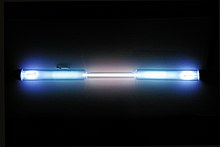کرېپټون
ښکارېدونکې بڼه
(له Krypton نه مخ گرځېدلی)
 A krypton-filled discharge tube glowing white | |||||||||||||||||||||||||||||||||||||||||
Spectral lines of krypton | |||||||||||||||||||||||||||||||||||||||||
| عمومي خواص | |||||||||||||||||||||||||||||||||||||||||
|---|---|---|---|---|---|---|---|---|---|---|---|---|---|---|---|---|---|---|---|---|---|---|---|---|---|---|---|---|---|---|---|---|---|---|---|---|---|---|---|---|---|
| Pronunciation | /ˈkrɪptɒn/ KRIP-ton | ||||||||||||||||||||||||||||||||||||||||
| Appearance | colorless gas, exhibiting a whitish glow in an electric field | ||||||||||||||||||||||||||||||||||||||||
| Krypton په دوراني جدول کې | |||||||||||||||||||||||||||||||||||||||||
| اټومي شمیره (Z) | 36 | ||||||||||||||||||||||||||||||||||||||||
| گروپ, پیریود | group 18 (noble gases), period 4 | ||||||||||||||||||||||||||||||||||||||||
| بلاک | p-block | ||||||||||||||||||||||||||||||||||||||||
| Element category | noble gas | ||||||||||||||||||||||||||||||||||||||||
| معياري اټومي وزن (Ar) | کينډۍ:Val[۱] | ||||||||||||||||||||||||||||||||||||||||
| Electron configuration | [Ar] 3d10 4s2 4p6 | ||||||||||||||||||||||||||||||||||||||||
Electrons per shell | 2, 8, 18, 8 | ||||||||||||||||||||||||||||||||||||||||
| فزیکي خواص | |||||||||||||||||||||||||||||||||||||||||
| حالت (at STP) | گاز | ||||||||||||||||||||||||||||||||||||||||
| دويلې کيدو ټکى | 115.78 K (−157.37 °C, −251.27 °F) | ||||||||||||||||||||||||||||||||||||||||
| يشنا ټکی | 119.93 K (−153.415 °C, −244.147 °F) | ||||||||||||||||||||||||||||||||||||||||
| کثافت (at STP) | 3.749 g/L | ||||||||||||||||||||||||||||||||||||||||
| when liquid, at b.p. | 2.413 g/cm3[۲] | ||||||||||||||||||||||||||||||||||||||||
| Triple point | 115.775 K, 73.53 kPa[۳][۴] | ||||||||||||||||||||||||||||||||||||||||
| Critical point | 209.48 K, 5.525 MPa[۴] | ||||||||||||||||||||||||||||||||||||||||
| Heat of fusion | 1.64 kJ/mol | ||||||||||||||||||||||||||||||||||||||||
| Heat of vaporization | 9.08 kJ/mol | ||||||||||||||||||||||||||||||||||||||||
| Molar heat capacity | 20.95[۵] J/(mol·K) | ||||||||||||||||||||||||||||||||||||||||
Vapor pressure
| |||||||||||||||||||||||||||||||||||||||||
| اټومي خواص | |||||||||||||||||||||||||||||||||||||||||
| Oxidation states | 2, 1, 0 (rarely more than 0; unknown oxide) | ||||||||||||||||||||||||||||||||||||||||
| Electronegativity | Pauling scale: 3.00 | ||||||||||||||||||||||||||||||||||||||||
| Ionization energies |
| ||||||||||||||||||||||||||||||||||||||||
| Covalent radius | 116±4 pm | ||||||||||||||||||||||||||||||||||||||||
| Van der Waals radius | 202 pm | ||||||||||||||||||||||||||||||||||||||||
| Miscellanea | |||||||||||||||||||||||||||||||||||||||||
| Crystal structure | face-centered cubic (fcc) | ||||||||||||||||||||||||||||||||||||||||
| Speed of sound | (gas, 23 °C) 220 m·s−1 (liquid) 1120 m/s | ||||||||||||||||||||||||||||||||||||||||
| د تودوخې تېرېدنه | 9.43×10−3 W/(m·K) | ||||||||||||||||||||||||||||||||||||||||
| Magnetic ordering | diamagnetic[۶] | ||||||||||||||||||||||||||||||||||||||||
| Magnetic susceptibility (χmol) | −28.8·10−6 cm3/mol (298 K)[۷] | ||||||||||||||||||||||||||||||||||||||||
| CAS Number | 7439-90-9 | ||||||||||||||||||||||||||||||||||||||||
| History | |||||||||||||||||||||||||||||||||||||||||
| Discovery and first isolation | William Ramsay and Morris Travers (1898) | ||||||||||||||||||||||||||||||||||||||||
| Main isotopes of krypton | |||||||||||||||||||||||||||||||||||||||||
| |||||||||||||||||||||||||||||||||||||||||
کرېپټون (په انگرېزي: Krypton) له کیمیاوي عناصرو څخه یو دی چې په تناوبي جدول کې د Kr سمبول او ۳۶ اتمي شمېرې په وسیله ښودل شوی دی.
مشخصات
[سمول]تاریخچه
[سمول]مرکبات
[سمول]د استعمال ځایونه
[سمول]سرچينې
[سمول]- ↑ Meija, J.; Coplen, T. B. (2016). "Atomic weights of the elements 2013 (IUPAC Technical Report)". Pure Appl. Chem. 88 (3): 265–91. doi:10.1515/pac-2015-0305.
{{cite journal}}: Unknown parameter|displayauthors=ignored (|display-authors=suggested) (help) - ↑ Krypton. encyclopedia.airliquide.com
- ↑ "Section 4, Properties of the Elements and Inorganic Compounds; Melting, boiling, triple, and critical temperatures of the elements". CRC Handbook of Chemistry and Physics (85th ed.). Boca Raton, Florida: CRC Press. 2005.
- ↑ ۴٫۰ ۴٫۱ کينډۍ:RubberBible92nd
- ↑ Shuen-Chen Hwang, Robert D. Lein, Daniel A. Morgan (2005). "Noble Gases". Kirk Othmer Encyclopedia of Chemical Technology. Wiley. pp. 343–383. doi:10.1002/0471238961.0701190508230114.a01.
- ↑ Magnetic susceptibility of the elements and inorganic compounds, in Lide, D. R., ed. (2005). CRC Handbook of Chemistry and Physics (86th ed.). Boca Raton (FL): CRC Press. ISBN 0-8493-0486-5.
- ↑ Weast, Robert (1984). CRC, Handbook of Chemistry and Physics. Boca Raton, Florida: Chemical Rubber Company Publishing. pp. E110. ISBN 0-8493-0464-4.
- ↑ Patrignani, C.; et al. (Particle Data Group) (2016). "Review of Particle Physics". Chinese Physics C. 40 (10): 100001. doi:10.1088/1674-1137/40/10/100001. See p. 768
| |||||||||||||||||||||||||||||||||||||||||||||||||||||||||||||||||||||||||||||||||||||||||||||||||||||||||||||||||||||||||||||||||||||||||||||||||||||||||||||||||||||||||||||||||||||||||||||||||||||||||||||||||||||||||||||||||||||||||||||||||||||||||||||||||||||||||||||||||||||||||||||||||||||||||||||||||||||||||||||||||||||||||||


